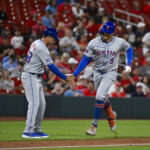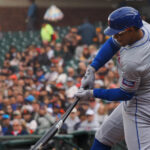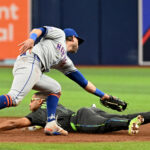
Sandwiched between the fact that he regularly played through injuries and his lone playoff appearance as a Met came in the shadows of far superior hitters in Carlos Beltran, David Wright, Jose Reyes, and Carlos Delgado, fans tend to forget just how valuable Cliff Floyd was to the Mets offense in the early and mid-2000s.
Signed on January 9th, 2003 to a four-year, $26 million deal, Floyd had compiled an impressive .284/.361/.494 line through his first ten years in the league, albeit at an average of just 96 games played per season. Between the Marlins, Expos, and a half-season with the Red Sox, Floyd’s career .853 OPS ranked 14th (minimum 3000 plate appearances) among National League outfielders – a pretty impressive mark when you consider just how many Hall of Famers and Steroid Era superstars make up the list.
Possibly the biggest commitment the club had made to a free agent bat since they re-signed Mike Piazza in 1999, Floyd came with his share of expectations as not only a player, but also a piece of a greater effort to turn the page on a pedestrian 2002 season.
The Mets had already signed lefties Tom Glavine (three years, $35 million) and Mike Stanton (three years, $9 million) to solidify the pitching staff, and had dismissed longtime skipper Bobby Valentine, replacing him with Art Howe. Add the left fielder Floyd to a veteran lineup that featured the likes of Mo Vaughn, Roberto Alomar, Roger Cedeno, Jeromy Burnitz, and (of course) Piazza, and the team had seemingly done its due diligence in building a winner.
By the end of the year however, Floyd was one of a select few standing: The aforementioned five bats combined for just a 1.4 bWAR – Floyd, meanwhile, managed a 2.7. All told, his win-share was the fourth-highest on the team, and the best among offensive players. His 18 homers tied Burnitz for the club lead, his 68 RBI ranked second behind a young, promising third baseman named Ty Wigginton, and his .894 OPS led the team by a hearty 79 points.
His .348/.425/.506 line in the second half, coupled with the arrival of shortstop prospect Jose Reyes and a breakout campaign from first baseman Jason Phillips seemed to be a good sign of things to come, though an Achilles injury in mid-August cut Floyd’s season off at 108 games. In Floyd’s absence, the Mets would go just 12-26 through the end of the year and finish with a brutal 66-95 record.
Team GM Steve Phillips would give the renovate-with-veterans strategy another try, signing Mike Cameron, Braden Looper, and Todd Zeile while winning an overseas bid for Kazuo Matsui, a highly-coveted NPB infielder. This 2004 squad would still eclipse 90 losses (71-91), however, and Floyd, despite playing in five more games than the prior year, dealt with even more nagging injuries. Some of his numbers started to decline.
During his second year with the club, Floyd’s strikeout count rose drastically from 66 to 103, and his -1.1 dWAR in left field tied a career-low. He slugged just .393 in the second half, and his .632 OPS against lefties marked a nearly-200 point drop from the prior season. Even so, he still hit another 18 home runs, managed 183 total bases (not far off from the 189 from his first year), and maintained an OPS north of .800.
In Met lore, there seem to be a freakish amount of aging hitters riding long-term contracts and/or greater waves of expectations, and the vast majority of these stories end in disappointment. Floyd’s aggregate numbers fit a more positive narrative, however, and if anything, his latter two seasons would cement his place as one of the better Met outfielders in franchise history.
Over 150 games in 2005 – the second-highest mark of his career – Floyd led the team with 34 home runs – the highest mark of his career. He finished second to David Wright (the other young, promising third baseman) in nearly every other standard offensive category (98 RBI, 278 total bases, 63 walks, and a .273 batting average). He’d also bounce back in the field, tying a career-high with a 0.6 dWAR and finishing seventh among big-league outfielders with 12 DRS. His 15 assists ranked second behind Manny Ramirez.
On single-season leaderboards, Floyd’s .863 OPS in 2005 ranks sixth all-time among left fielders between 2016 Yoenis Cespedes and 1971 Cleon Jones. His .233 ISO comes in fifth between 1981 Dave Kingman and 1962 Frank Thomas.
Floyd’s 1.000 OPS in 187 plate appearances with men in scoring position ranked 21st in all of baseball that year. With two outs, moreover, Floyd’s 1.071 in 87 plate appearances ranked 20th. Arguably his most memorable at-bat in a Met uniform came in this exact scenario against the Los Angeles Angels (of Anaheim) on June 11th.
The Mets had originally tied the game in the bottom of the ninth after Marlon Anderson came around on a pinch-hit, inside-the-park home run off Francisco Rodriguez, but again found themselves down a run just an inning later. With Reyes at third and Cameron at first and two dead against Brendan Donnelly, Floyd launched an outside fastball over the wall in right-center to win the game by a final of 5-3.
The Mets – now managed by Willie Randolph – couldn’t weave any noteworthy winning streak out of Floyd’s heroics, but ultimately finished the season just four games over .500. He’d receive an MVP vote for just the second time in his career, and between Wright’s immediate impact, Reyes’ continued rise out of the leadoff spot, and a formidable season on the mound from Pedro Martinez, the team finally had tangible momentum.
Sophomore GM Omar Minaya added to the core by trading for Carlos Delgado and Paul Lo Duca while signing an elite closer in Billy Wagner. Carlos Beltran bounced back from a mediocre first-year showing to receive serious consideration for an MVP award. The 2006 team won 97 games. But in a cruel twist of fate, Floyd, the Mets’ best offensive weapon the prior year would only play in 97 games.
Now 34 years of age, Floyd’s lower body maladies had finally managed to force him off the field on not one, but two separate month-long stints. His average fell to .188 in late-April, and he wouldn’t find his way off the interstate for another three weeks.
Even as his spot in the batting order continued to fall through the second month of the season, Floyd plugged away, hitting .269/.377/.471 through June 6th before a sprained ankle put him on the injured list. He still hit a few tanks, including this one against the Atlanta Braves, which sent a home opener with the defending division champs into extra innings.
The Mets emerged victorious after 14 innings, and would only lose two more games to the Braves before winning their first divisional crown in 18 years on September 18th.
Upon returning from another Achilles injury in September, Floyd would only start in back-to-back games three times, and would only twice manage to do so playing through the full nine innings. Nonetheless, in one such game against the Marlins, Floyd would catch the final out – the clinching out against the Marlins, no less.
Cliff’s .659 OPS for the month and continued trouble staying on the field presented conflict as the club headed into its first postseason matchup against the Los Angeles Dodgers. Nonetheless, he’d manage to make the lineup in the first game of the NLDS, and moreover his first postseason start in a 14-year career.
Floyd grounded out to second in his first at-bat against Derek Lowe, but came back in the bottom of the fourth to launch a go-ahead solo home run to right-center field. The Mets would go on to win by a final of 6-5, and would sweep the series in three games – the last of which also saw a 2-for-2 performance with an RBI base hit.
Further injury limited Floyd’s NLCS to three plate appearances – the latter two in pinch-hit roles in the fifth and seventh games – as Endy Chavez assumed regular left-field duties for the majority of the series against St. Louis.
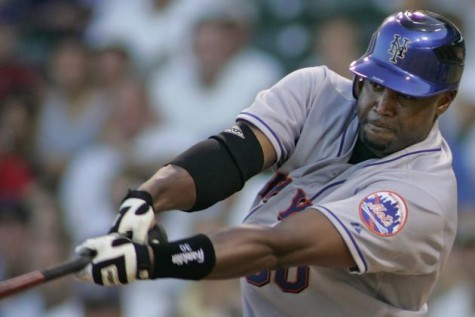
The veteran outfielder’s final at-bat came with runners on first and second and none out in the bottom of the ninth against then-closer Adam Wainwright. Down 3-1, the Mets opted for the power bat over a sacrifice bunt, and Floyd, like Beltran an infamous two batters latter, took a curveball over the plate for strike three.
Floyd himself has expressed both disappointment and relief over the results of the at-bat, which barely receive a fraction of the press of that haunting final out: “People say ‘you should have swung… I couldn’t swing at it. If I hit that ball, it’s on the ground, it’s either back to him or to the second baseman, and either way it’s a double play.”
On a damp, chilly night with a physically limited hitter at the plate, I don’t necessarily blame Floyd for taking this stance, but I still wonder from time to time where the ball lands if he gets a better pitch to hit. As he said himself the following year, “I look back on that at-bat and I missed two or three pitches I could have put in play… I’ve watched it a couple times. I just wish I could have hit the pitches before.”
One of five Mets who had to endure the nightmares of 2003 and 2004 before getting to contribute to a winning ballclub (the other four being Reyes, Glavine, Steve Trachsel, and Aaron Heilman), Floyd probably deserved a better ending.
Fortunately, in the proceeding two years after he left via free agency, Floyd got something the Mets never would for another nine years: two playoff appearances and one trip to the World Series.
Cliff first signed with the Chicago Cubs for the 2007 season, sharing part-time duties with Matt Murton, Jacque Jones, and Mark DeRosa in an injury-free campaign that saw him hit .284/.373/.422 en route to a divisional title. Unfortunately, he’d go hitless in his eight plate appearances as the Cubs took a sweeping at the hands of the Arizona Diamondbacks.
Floyd joined the Tampa Bay Rays on a one-year, $3 million deal for 2008, serving almost exclusively as a designated hitter against right-handed pitching in 80 games. Floyd would hit .268/.349/.455 with a 0.9 bWAR, good enough to receive starts in six of the Rays’ first 11 postseason contests and an additional nod in Game 2 of the World Series against Philadelphia. Overall, he went 4-for-18 with a double in the ALDS and a homer in the ALCS.
Following the World Series loss, Floyd took a minors pact with the San Diego Padres, but lasted ten games before tearing a labrum in his shoulder. The club released him in October, and he promptly retired.
Since calling it quits on the field, Floyd has kept close to the Met family, taking part in 2013 All-Star Game festivities at Citi Field and serving occasional spring training and postgame commentary for SNY back in 2015. He was on-hand for the retirement of Mike Piazza’s uniform number in July 2016, and also took part in festivities during David Wright’s final game on the baseball field in September 2018.
His .478 slugging percentage as a Met ranks ninth all-time, and his .354 on-base percentage 15th. He also ranks 40th all-time in offensive WAR (7.6), beating out the likes of Carlos Delgado, Dave Kingman, and Robin Ventura.





